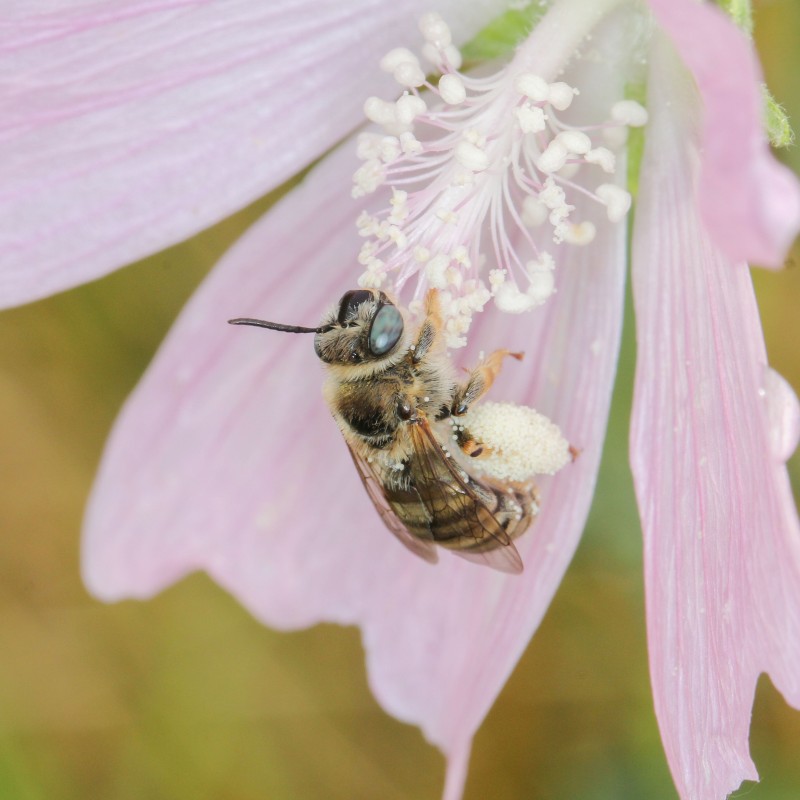Wild bee diversity in sharp decline in eastern Marchfeld region
21. August 2023
Boasting more than 700 recorded species, Austria is a European hot spot of wild bee diversity. The number of species recorded
in Lower Austria alone is higher than that found in all of Germany. A current study published by researchers of the Natural
History Museum (NHM) Vienna and the University of Natural Resources and Applied Life Sciences (BOKU) Vienna documents the
changes found in wild bee populations and landscapes in and around the “Sandberge Oberweiden” nature reserve in the eastern
Marchfeld region.
It has been known since the late 19th century that the sandy soils and steppe-like character
of this area favour an extraordinarily high number of specialised, rare bee species. This situation offered a unique opportunity
for chronicling changes over a longer period of time. “Unlike other studies that identified the decline of species diversity
in the last 5 decades, this project enabled us to analyse changes in wild bee fauna and their habitats over 100 years,” notes
first author Dr. Dominique Zimmermann of the NHM Vienna.
As the results show, the number of species found on the site has declined by 50 percent over the last 100 years – 164 out of 289 species have not been identified on site for more than 50 years, and many species were already rare 50 years ago. Fourteen species recorded on the site in the past are now considered extinct throughout Austria. The species particular affected are those adapted to steppe and sandy territory and species that build their nests in the ground. Moreover, the researchers also observed an over-proportional decline in cuckoo bee species. Cuckoo bees lay their eggs in the nests of other bees, and their decline suggests that the populations of their host bee species are unstable as well.
In general, the results indicate that changes in land use (windbreaks, cultivation, excess fertilisation) in the first half of the 20th century or even earlier resulted in the disappearance of structures that ground-nesting bee species need for their nests: areas of ground without vegetation have been increasingly replaced by wooded structures and dense grass cover. Another consequence of these developments is a reduced supply of flowering plants, thus depriving wild bees of their food source.
In order to improve the conditions for wild bees in the area, it would be desirable to revert to historical practices of land management such as short-term intensive grazing and rotational mowing on small areas.
The publication:
https://doi.org/10.1007/s10841-023-00486-8
Research contact:
Dr. Dominique Zimmermann
Kuratorin Hymenoptera, 2. Zoologische Abteilung des NHM Wien
Tel.: +43 (1) 52177 – 316
dominique.zimmermann@nhm-wien.ac.at
Inquiries:
Mag. Irina Kubadinow
Leitung Presse & Öffentlichkeitsarbeit, Pressesprecherin
Tel.: + 43 (1) 521 77 – 410
irina.kubadinow@nhm-wien.ac.at
Mag. Anton Zwischenberger
Presse & Öffentlichkeitsarbeit
Tel.: + 43 (1) 521 77 – 411
anton.zwischenberger@nhm-wien.ac.at
As the results show, the number of species found on the site has declined by 50 percent over the last 100 years – 164 out of 289 species have not been identified on site for more than 50 years, and many species were already rare 50 years ago. Fourteen species recorded on the site in the past are now considered extinct throughout Austria. The species particular affected are those adapted to steppe and sandy territory and species that build their nests in the ground. Moreover, the researchers also observed an over-proportional decline in cuckoo bee species. Cuckoo bees lay their eggs in the nests of other bees, and their decline suggests that the populations of their host bee species are unstable as well.
In general, the results indicate that changes in land use (windbreaks, cultivation, excess fertilisation) in the first half of the 20th century or even earlier resulted in the disappearance of structures that ground-nesting bee species need for their nests: areas of ground without vegetation have been increasingly replaced by wooded structures and dense grass cover. Another consequence of these developments is a reduced supply of flowering plants, thus depriving wild bees of their food source.
In order to improve the conditions for wild bees in the area, it would be desirable to revert to historical practices of land management such as short-term intensive grazing and rotational mowing on small areas.
The publication:
https://doi.org/10.1007/s10841-023-00486-8
Research contact:
Dr. Dominique Zimmermann
Kuratorin Hymenoptera, 2. Zoologische Abteilung des NHM Wien
Tel.: +43 (1) 52177 – 316
dominique.zimmermann@nhm-wien.ac.at
Inquiries:
Mag. Irina Kubadinow
Leitung Presse & Öffentlichkeitsarbeit, Pressesprecherin
Tel.: + 43 (1) 521 77 – 410
irina.kubadinow@nhm-wien.ac.at
Mag. Anton Zwischenberger
Presse & Öffentlichkeitsarbeit
Tel.: + 43 (1) 521 77 – 411
anton.zwischenberger@nhm-wien.ac.at


